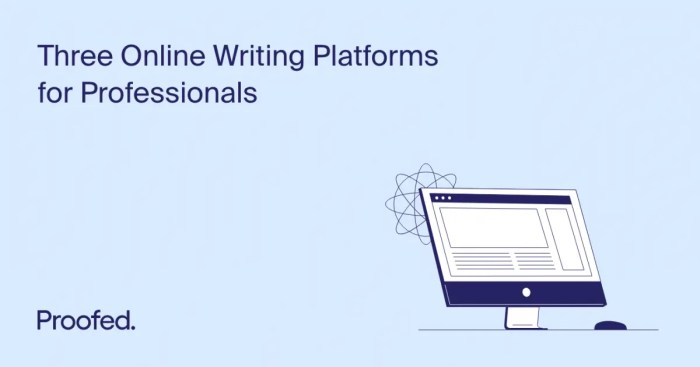Writing for Multiple Platforms opens up a world of possibilities for content creators, allowing them to tailor their message to different audiences with finesse. From customizing content to maintaining consistency, this guide delves into the art of multi-platform writing.
Exploring the nuances of engaging audiences and repurposing content, this discussion promises to equip you with the tools needed to excel in the ever-evolving digital landscape.
Platforms for Writing
Writing for multiple platforms offers writers the opportunity to reach diverse audiences and showcase their work in various formats. Each platform comes with its own set of advantages and disadvantages, impacting how content is consumed and shared. Let’s explore some popular platforms for writing and their unique characteristics.
Blogs
- Blogs provide a space for writers to express their thoughts, opinions, and expertise on specific topics.
- Advantages:
- Easy to set up and maintain.
- Allows for direct interaction with readers through comments.
- Great for building a personal brand or online presence.
- Disadvantages:
- May require consistent updates to maintain reader engagement.
- Competition can be high in popular blogging niches.
- Example: The Huffington Post features a variety of blog posts from contributors on topics ranging from politics to lifestyle.
Social Media
- Social media platforms like Twitter, Instagram, and Facebook offer quick and easy ways to share short-form content.
- Advantages:
- Reach a large audience quickly through shares and retweets.
- Engage with followers in real-time conversations.
- Visual content performs well on platforms like Instagram.
- Disadvantages:
- Content can get lost in the constant stream of updates.
- Character limits on platforms like Twitter may restrict the depth of content.
- Example: The Twitter account for The New York Times shares breaking news updates and links to full articles.
Medium
- Medium is a platform that combines elements of traditional blogging with social networking features.
- Advantages:
- Allows writers to reach a built-in audience of readers interested in diverse topics.
- Features a clean and user-friendly interface for writing and reading content.
- Enables writers to earn money through the Medium Partner Program.
- Disadvantages:
- Competition for visibility among thousands of writers on the platform.
- Changes in the Medium algorithm can impact the reach of content.
- Example: Medium’s “OneZero” publication covers in-depth stories on technology and science.
Tailoring Content for Different Platforms
When it comes to writing for different platforms, it’s crucial to understand the unique characteristics and expectations of each platform. Customizing your content to fit the specific platform can help you reach a wider audience and maximize engagement. Adapting your writing style to suit the preferences of different audiences is key in capturing their attention and keeping them interested. Repurposing content for multiple platforms can save you time and effort while ensuring consistency across your marketing channels.
Customizing Content for Specific Platforms
To tailor your content for specific platforms, start by researching the demographics, interests, and behaviors of the audience that frequents each platform. For example, content on Instagram should be visually appealing and concise, while content on LinkedIn may require a more professional and informative tone. Adjusting the format, language, and tone of your content to align with the platform’s style can help you better connect with your target audience and drive engagement.
Adapting Writing Style for Different Audiences
Understanding the preferences and expectations of different audiences is crucial in adapting your writing style. Consider the age, interests, and communication preferences of your target audience when crafting content for specific platforms. For instance, a younger audience may prefer informal language and trendy references, while an older audience may appreciate a more formal and informative approach. By tailoring your writing style to suit the preferences of your audience, you can create content that resonates with them and encourages interaction.
Tips on Repurposing Content for Multiple Platforms
When repurposing content for multiple platforms, focus on adapting the format and presentation to fit the requirements of each platform. Consider breaking down longer pieces of content into shorter posts for platforms like Twitter or Facebook, or creating visually appealing graphics for platforms like Pinterest or Instagram. Repurposing content in different formats can help you reach a broader audience and increase the visibility of your brand across various channels.
Remember to maintain consistency in messaging and branding across all platforms to reinforce your brand identity and build a strong online presence.
Consistency Across Platforms

Maintaining consistency in tone and messaging across different platforms is crucial for building a strong brand identity and connecting with your audience effectively. By using the following strategies, you can ensure that your content remains consistent no matter where it is being published.
Share strategies for maintaining consistency in tone and messaging
- Create brand guidelines: Develop a style guide that Artikels your brand’s tone of voice, messaging, and key values. This will serve as a reference point for all content creators across platforms.
- Use consistent visuals: Ensure that your graphics, colors, and overall visual identity are consistent across all platforms. This helps in reinforcing brand recognition.
- Train your team: Provide training to your team members on the importance of consistency and how to maintain it. Regular check-ins and feedback can also help in this process.
Discuss the challenges of keeping content consistent across platforms, Writing for Multiple Platforms
One of the main challenges of maintaining consistency across platforms is the different audience preferences and behaviors on each platform. What works on Twitter may not work on Instagram, so adapting content while maintaining consistency can be tricky.
Provide examples of brands that excel in maintaining consistency
- Apple: Apple is known for its consistent branding across all platforms, from its sleek design to its minimalist messaging.
- Nike: Nike’s “Just Do It” slogan and iconic swoosh logo are instantly recognizable across all channels, showcasing their commitment to consistency.
- Coca-Cola: Coca-Cola’s red and white color scheme and classic logo have remained consistent for decades, solidifying their brand identity.
Engaging Audiences on Various Platforms: Writing For Multiple Platforms

Crafting engaging content for different platforms is essential in capturing the attention of diverse audiences. Each platform has its own unique features and audience demographics, so tailoring the content to fit the preferences of each platform is crucial. For example, short and catchy captions work well on platforms like Twitter, while longer-form content may be more suitable for platforms like LinkedIn or Medium.
Role of Visuals, Video, and Interactive Elements
Visuals, videos, and interactive elements play a significant role in engaging audiences across various platforms. Eye-catching images or videos can grab the audience’s attention and convey messages more effectively than plain text. Including interactive elements such as polls, quizzes, or live streams can also encourage audience participation and create a more immersive experience.
- Visuals: Incorporating high-quality images, infographics, and illustrations can make the content more visually appealing and easier to digest.
- Video: Utilizing videos for storytelling, product demos, or behind-the-scenes footage can increase engagement and keep the audience interested.
- Interactive Elements: Adding interactive features like polls, surveys, or interactive infographics can make the content more engaging and encourage audience interaction.
Case Studies of Successful Engagement Strategies
- Red Bull: The energy drink company has successfully engaged audiences across various platforms by sharing extreme sports videos, organizing events, and creating interactive content like games and quizzes.
- BuzzFeed: The media company uses a combination of listicles, videos, and interactive quizzes to engage audiences on platforms like Facebook, Instagram, and Snapchat.
- Nike: The sportswear brand engages its audience through visually appealing images, videos featuring athletes, and interactive campaigns like the Nike Run Club app.